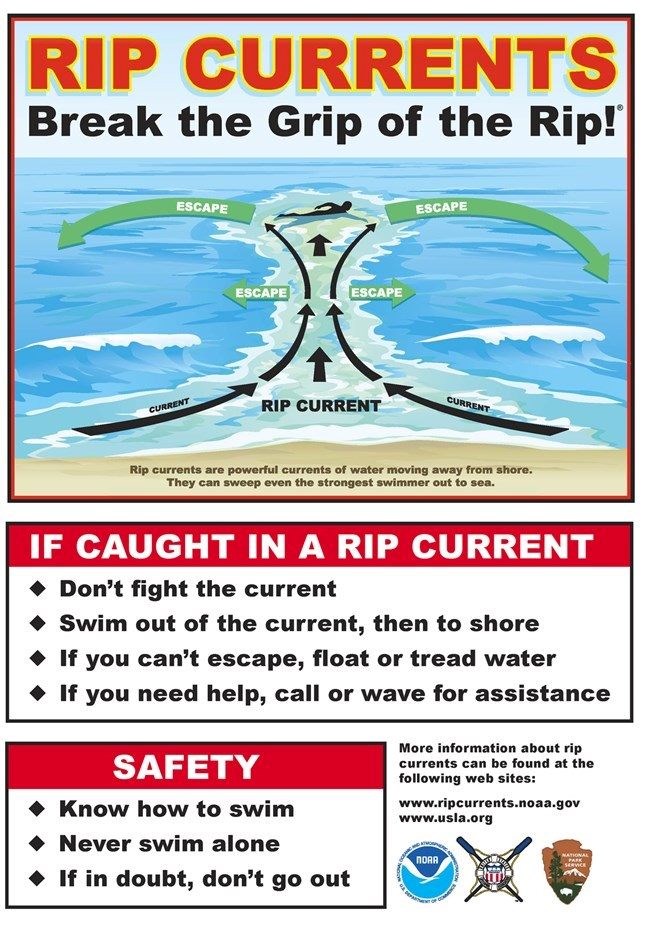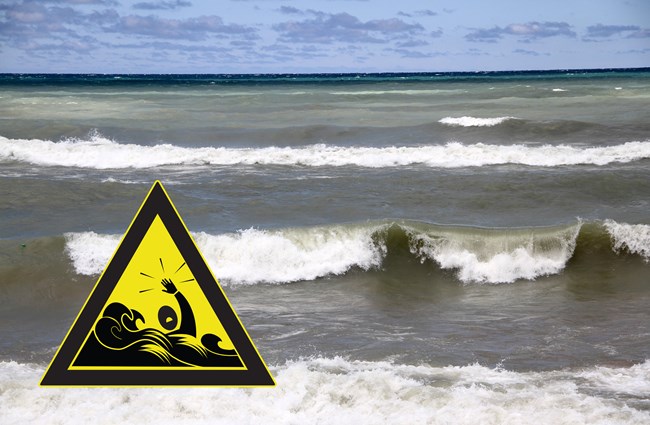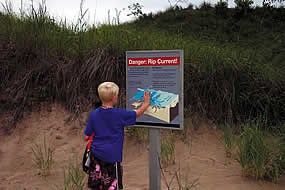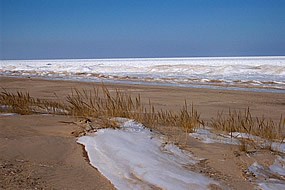Your Safety is Your ResponsibilityBefore heading out on any trip, take time to check the weather, make sure everyone in your group is prepared for the anticipated conditions, and be prepared to turn back if conditions change. 
CDC/ James Gathany; William L. Nicholson, Ph.D. Ticks:Ticks can be active anytime during the year, especially when temperatures are warmer than 40° F. As temperatures warm, ensure you check yourself, your children, and your pets regularly for ticks. Some ways to prevent tick bites include the following:

Rip CurrentsBe on the lookout this summer for rip currents on Lake Michigan. Before your next visit to the beach, learn how to spot a rip current and what to do if you get caught in one. Always check the local beach forecast for any warnings, and exercise caution. If Caught in a Rip Current
Rip Current Safety
More information about rip currents can be found at the following websites: www.ripcurrents.noaa.gov and www.usla.org.
Know Before You Go!
Water SafetyDo not swim when rip current warnings are posted or large crashing waves are present, which can cause rip currents. These strong currents rush out into Lake Michigan and can carry even the strongest swimmer with them. If you get caught in a rip current, do not try to swim against it. Instead, swim parallel to the shoreline until you are out of the current. Lake Michigan is generally clean and safe for swimming but it can become contaminated with harmful bacteria. Do not enter the water when a health hazard warning is issued or posted. If you do, you risk intestinal illness, skin rash, or eye, ear or respiratory infections. Tick and Insect SafetyAvoid diseases carried by biting pests by checking yourself for ticks after being outdoors. Use insect repellent and wear light colored, long-sleeved shirts and tucked-in pants to help prevent both tick and mosquito bites. To help prevent mosquito bites, limit outside activities at dusk and dawn when mosquitoes are most prevalent. Beware of yellow jackets and other stinging insects. Avoid loose-fitting clothing and bright, flowered prints. Do not wear sandals; avoid wearing perfume, lotion and hairspray. Never swat at a flying insect. Look for insects before you drink from open beverage cans. When eating outdoors, keep food covered. Insect repellents DO NOT work against stinging insects. Seek immediate medical attention if you are stung and have symptoms of a systemic allergic reaction. Systemic reactions include hives, swelling of the eyes, lips, tongue, throat or sting area, intense general itching, difficulty breathing, irregular heartbeat, nausea and loss of consciousness. 
CDC Heat SafetyHeat stroke, heat exhaustion, heat cramps, sunburns, and heat rash are examples or heat-related illness. Heat-related illnesses are serious and can lead to death if not treated quickly. Stay cool, hydrated, and informed to beat the heat while visiting the park!

Plant SafetyFor your safety, please stay on officially designated trails and avoid brushing against vegetation. Multiple species of plants can cause skin irritation to visitors. A few notable plants to avoid include: Poison Ivy + Poison Sumac:Allergic contact dermititus: Urushiol oils present on the surface of plants can cause itchy allergic reactions that last over a week. Oils can pass onto skin by brushing up against plant leaves, stems, or vines. Posion ivy is a native plant species that is abundant along many trails. Posion sumac is a native plant species that is confined to few wetlands in the park. Poison Hemlock: Phytophotodermititus:Sap from inside the plant makes skin highly susceptible to UV damage from sunlight and can cause painful blisters and chemical burns. This invasive plant species can be 5-12 feet tall, has white flowers, and is common in disturbed areas along roads and trails. This plant is locally abundant along the newly paved portion of the Marquette Greenway Trail through the City of Portage and the Town of Burns Harbor. Avoid breaking plant stems or leaves to avoid sap. FireworksWARNING: Individuals, groups or organizations may not possess or use fireworks within the park boundary. People may not pollute the park with fireworks debris by launching from adjacent areas so that the fallout enters into the park. The use of fireworks not only disturb both visitors and wildlife, but can potentially start a dangerous wildfire. The park has previously experienced a wildfire in the past due to individuals shooting off fireworks. The fire came close to a park structure, but was put out by a park visitor and emergency personnel. Individuals found in violation will have their fireworks seized and face a fine up to $5,000 and/or 6 months in jail. Fireworks are also prohibited at the Indiana Dunes State Park. 
Winter SafetyKnow where you can sled:Due to hidden dangers, often partially covered by shifting sands, sledding, inner-tubing, tobogganing, skiing and snowboarding are prohibited in most of the park. Sledding is permitted at only one location: just southwest of the West Beach picnic shelters on the east-facing slope of the West Beach Trails. Sledding is prohibited on marram grass and is only permitted when adequate snow cover is present. Please call the Indiana Dunes Visitor Center at 219-395-1882 with any questions. Stay off the ice:When frozen, Lake Michigan looks much like the Arctic. Unlike the arctic landscape, the lake ice is full of hidden thin spots and gaps (often further hidden by a layer of snow). Venturing out onto the ice is a sure way to risk death. For more information, visit our Shelf Ice page. Walking on shelf ice is extremely hazardous. Persons falling through hidden holes and weak spots can quickly disappear from view making rescue difficult. Death is likely. Ponds, creeks and other waterways are not monitored for safe ice conditions. Subsurface water flows can create unseen thin areas making these locations unsafe. Access to frozen ponds places wintering animals under additional human-caused stress. Stay warm:Dress in layers of loose-fitting clothes (including headwear) and keep your feet and hands dry. Minimize exposed skin. Keep an eye on the wind chill to help prevent frostbite. Gently re-warm any waxy-looking skin and seek medical attention. Dressing properly can also prevent hypothermia. Early signs of this potentially fatal cooling of the body include intense shivering, loss of coordination and confusion. If you see symptoms, seek warmth and immediate medical care. Prime temperatures for hypothermia are actually above freezing between 30-50ºF. Don’t hike alone. To best prepare for safe and enjoyable winter hiking, check out these Winter Hiking Tips. |
Last updated: August 27, 2024
